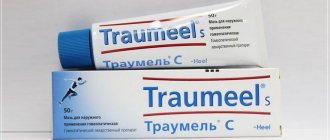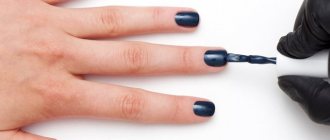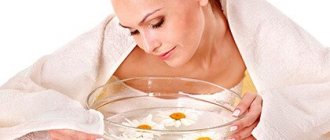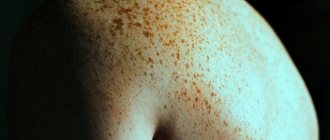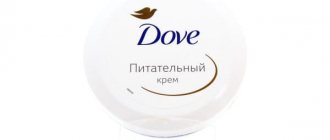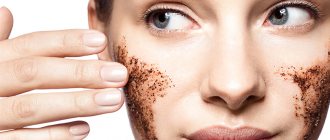The use of hydrogen peroxide for the face has been known for a long time. It is especially useful for teenage problem skin. Peroxide is excellent at drying out acne and reducing sebum production. Girls who want to get rid of freckles often resort to using this product. Ladies over 50 use it to lighten age spots. Everyone finds use for this controversial product. But how does peroxide actually work? And how to make its use as safe as possible?
Effect of hydrogen peroxide
Despite the fact that peroxide is quite widely used in cosmetology, its use is unsafe and not harmless for the skin. Hydrogen peroxide is an aggressive substance. It is essentially water with an extra oxygen atom attached to it. Upon contact with the skin, the compound is destroyed and an oxidation reaction occurs. By combining with dirt, sweat and germs on the surface of the dermis, oxygen softens them and makes them easier to remove from the face. But it also results in microscopic burns that make the skin look whiter and clearer.
How does peroxide affect facial skin?
Hydrogen peroxide (hydrogen peroxide, H2O2) is a powerful oxidizing agent with three main properties:
- Oxidative. Peroxide destroys microbes, calms inflammation, promotes rapid healing of pimples, ulcers, and small wounds.
- Whitening. Active oxygen gives the skin a more even and lighter tone, making dark age spots and freckles on the face less noticeable.
- Foaming. Combining with ichor, pus and other organic matter, peroxide forms a vesicular base. When applied to a purulent and infected wound, it hisses, but remains inactive on a clean one.
Photo: www.ladywow.ru
Indications and contraindications
As mentioned above, hydrogen peroxide requires very careful handling, as it can cause serious damage to the skin in the form of a chemical burn. Also, the use of this substance is contraindicated for people who have:
- individual intolerance;
- excessively dry, flaky skin;
- skin diseases (psoriasis, eczema);
- damage and injury to the skin;
But who should make masks with peroxide are people:
- with enlarged pores;
- with oily skin type;
- with skin problems such as acne and acne;
- with freckles and age spots.
Contraindications
Hydrogen peroxide must be handled very carefully. Remember that in this case, more is not better, but quite the opposite.
If you overdo it with the amount of peroxide while preparing a whitening mask or compress, you can get a very real burn. The same result will occur if used too often. Instead of the expected lightening and even tone without blemishes, the skin will receive additional damage and even scars.
You should not use peroxide to remove pigmentation if you have:
- individual intolerance;
- too dry, prone to peeling, sensitive skin;
- there are any wounds - eczema, herpes rashes, small scratches.
Safety precautions when working with peroxide
To prevent hydrogen peroxide from causing serious damage to the dermis, you need to work with it very carefully. It is important to follow the following safety rules.
- Use a 3% solution as higher concentrations can cause serious burns to the skin.
- Before using hydrogen peroxide, test your reaction to it. This can be done on any small area of skin - on the crook of the elbow or the back of the hand.
- Peroxide in its pure form can only be used spot-on - on freckles, pimples, blackheads.
- You can't make masks with peroxide too often. The optimal course of procedures is once a week for a month. Next you should take a break for 2-4 weeks.
- Those with dry skin should avoid using peroxide or soften its effect with components such as egg yolk, fatty oils, honey, etc.
- Do not allow peroxide to get into your eyes or mucous membranes. It is also not advisable for this product to come into contact with the delicate skin of the eyelids and lip area.
If you follow all the recommendations, the procedure using hydrogen peroxide will become almost completely safe and very effective. Peroxide successfully fights rashes, cleanses the skin and makes it brighter, smoother, and more beautiful.
Mask options
Masks have a less aggressive effect on the skin. The compositions must be prepared immediately before application, since even with short-term storage the beneficial properties of the product are lost. When choosing a recipe, consider the characteristics of your skin. So, if the epidermis is very oily, then mask options that contain oils should be avoided.
Potato
Using this composition, pigment spots are removed. In addition, the composition nourishes and rejuvenates the skin. To prepare, you need to peel a small potato and grate it on the finest grater. Add 5 ml of castor oil (preheat) and the same volume of peroxide solution to the potato mixture.
If the mass turns out to be too liquid, and therefore inconvenient for application, then you can thicken it by adding a little starch or oatmeal.
Curd
This is a very effective whitening mask that is suitable even for dry skin. To prepare the composition you will need fresh cottage cheese. The product must be rubbed through a sieve and mixed with full-fat sour cream to form a creamy mass. Add 10 drops of peroxide solution to the finished composition.
The second version of the curd whitening composition is suitable for those with oily skin. To prepare, you need to grind the cottage cheese and dilute it with peroxide to a thickness convenient for application.
Vinegar
This product whitens effectively, but it is absolutely not suitable for sensitive skin. To prepare the composition, it is recommended to choose natural apple cider vinegar; you can also use wine vinegar.
Never use acetic acid!
You need to slightly heat 10 ml of burdock or castor oil, then add 5 ml of peroxide and vinegar. Shake the mixture well. Soak cotton pads with the prepared oily solution and apply them to pigmented areas.
Soda
To prepare this composition you will need baking soda and clean water. It is better to take mineral water, but you can also use regular, purified water. In a quarter glass of water you need to dilute a full teaspoon of soda. Then add 3 ml of peroxide to the composition. Use the solution for lotions. Soak cotton pads in it and apply to pigmented areas.
Yeast
This composition whitens well and saturates the skin with B vitamins. But vitamin deficiency is one of the reasons for the appearance of excess pigmentation.
It is recommended to use dry yeast for preparation. The product must be diluted with peroxide to obtain a semi-liquid mass, let the mixture stand for about 5 minutes and apply to pigmented areas.
Lemon
This composition is used exclusively locally, as it is very drying. Therefore, you can only apply the product directly to the stain. You need to prepare lemon juice and mix it with a peroxide solution in a ratio of 1 to 2. Soak a cotton pad in the solution and apply to the stain. Try not to let the compress come into contact with healthy skin. If the stains are small, then it is better to apply the solution to them with a cotton swab. You need to keep this compress for no more than five minutes.
If your skin is very flaky after the procedure, you can try replacing lemon with grapefruit.
Yolk
This option is suitable for normal and dry skin. It is necessary to grind the yolk with 5 ml of cosmetic oil, for example, almond. Add 6 drops of peroxide to the prepared composition. Apply with a brush to pigmented areas for a quarter of an hour.
If you are intolerant to chicken eggs, you can prepare this whitening composition using three yolks from quail eggs.
Clay
To prepare this version of the mask, it is recommended to use white or blue cosmetic clay. Preparing the composition is very simple, you just need to dilute the clay with water until you get a thick paste. And then add 5 ml of peroxide solution to the composition. Apply the composition to problem areas.
With calendula tincture
To prepare this composition you will need calendula tincture. If your skin is prone to oily skin, an alcohol tincture is suitable. If the sebaceous glands function normally, then it is better to prepare a water infusion. You can buy an alcohol tincture ready-made at a pharmacy, but you will have to prepare a water tincture yourself.
To prepare the infusion, you need to pour a tablespoon of fresh calendula flowers (or half a tablespoon of dry raw materials) into a glass. Then pour boiling water into it, filling the container to half the volume. Cover the glass with a saucer, wrap it in a towel and leave for three hours. Then drain the liquid.
You will also need rice flour. If you don’t have this product at home, you can prepare it yourself by grinding grains of white rice in a coffee grinder. Mix a tablespoon of flour with a teaspoon of tincture and add enough peroxide to make a creamy mass. Apply the composition to pigmented areas.
With soap
This composition is recommended for whitening oily skin. To prepare, you will need baby soap without fragrances or fragrances. The soap needs to be grated; to prepare the mask you will need one teaspoon of shavings. The soap should be diluted in a tablespoon of peroxide solution, then 4 drops of salicylic alcohol should be added to the composition. Stir and apply locally to pigmented areas. This composition can also be used to whiten dry skin, but in this case, you will need to supplement the composition with 5 ml of unrefined vegetable oil.
With avocado
This version of the whitening composition softens well, so it is also suitable for epidermis prone to dryness. The basis of the composition is avocado puree. To prepare it, you need to take a ripe fruit (only half is needed).
The finished puree should be combined with 5 ml of peroxide and stirred well. Then gradually add starch, achieving a consistency convenient for application.
Bread
To prepare this bleaching composition you will need bran bread. You need to take a small piece, cut off the crusts and pour cold brewed chamomile or green tea over the crumb. Let it sit for a while and mash the crumb to a paste. Squeeze out excess liquid.
Mix bread gruel with a spoon of sour cream and 10 drops of hydrogen peroxide. Spread the mixture on gauze and apply the compress to the pigmented areas.
Oatmeal with cocoa
Prepare oatmeal and tar flakes in a coffee grinder.
Mix a tablespoon of flour with the same amount of cocoa powder. Pour a little boiling water into the mixture, the mass should turn out thick. Let the mixture stand until it cools completely, then pour in 5 ml of peroxide solution.
Using peroxide at home
Face masks
Curd mask
Take:
- cottage cheese (or heavy cream) – 1 spoon;
- hydrogen peroxide – 5-8 drops.
Mix the ingredients and apply them on your face. To prevent the cream from dripping, you can whip it before use. You need to walk with a mask for 15-20 minutes.
Bodyaga mask
Take:
- bodyagu – 4-5 grams;
- hydrogen peroxide - a few drops.
Combine the ingredients and stir until a homogeneous consistency is formed. Apply the paste to your face. Rinse off after 10 minutes. This mask dries out inflammation and treats acne.
Honey mask
This product will cleanse and nourish the skin very well. In addition, it has a gentle and gentle effect even on sensitive skin, so it is recommended for use for both dry and oily skin.
Take:
- honey – 1 spoon;
- aloe juice – 1 spoon;
- hydrogen peroxide – 2 drops;
- iodine – 2 drops.
Mix all ingredients. If you have very oily skin, you can add more peroxide - 4-5 drops. It is advisable to apply the mask only to problem areas, but it can be applied to the entire T-zone, especially if it has an oily sheen and increased sebum production. Rinse your face after 15-20 minutes.
Facial cleansing
This recipe is quite aggressive and is only suitable for very oily and problematic skin.
Take two bowls and pour hydrogen peroxide into one of them. Pour fine sea salt into another.
Dip a cotton pad into a bowl of peroxide, and then into a bowl of salt. Use the disc to gently wipe your face, paying special attention to areas of increased contamination - the nose, forehead and chin. After the cleansing massage is completed, rinse the mixture from your face with cool water. It is advisable to apply a soothing cream to your face immediately after the procedure, but make sure that it is light and does not clog the pores.
You can simply wipe your face with peroxide alone without salt, but this procedure is also quite aggressive and irritating to the skin.
Removal of age spots and freckles
Removing freckles will be quick and painless if you have hydrogen peroxide in the house.
To remove unwanted spots on the face, you can simply wipe the skin with it, or you can make a special product. To prepare you need only two ingredients:
- hydrogen peroxide – 2 tablespoons;
- potato starch – 1 spoon.
Mix the products to make a mask and apply the mixture to your face. After the mask dries, wash it off with water. After such a procedure, it is useful to wipe your face with water with the addition of lemon juice, because lemon is a well-known remedy for lightening the skin.
Another recipe involves using sour cream diluted with peroxide. The mixture is applied to the face with gentle movements and then washed off. This mask is good because it does not dry out the skin and is very gentle.
Lightening facial hair
You can lighten a mustache or too dark eyebrows in the following way. Take:
- soap - for foam;
- ammonia - 3-5 drops;
- hydrogen peroxide – 5 drops.
Advice
Soap suds can be replaced with shaving foam.
Rinse a bar of soap into a thick foam (or use a ready-made one), add ammonia and peroxide to it and apply to your hair. Leave the mixture on your face for a quarter of an hour, and then rinse with water. After 3 days, the procedure should be repeated.
After just a few applications, you will notice the result - your hair will noticeably lighten and will no longer be conspicuous.
In what cases should you refuse such a remedy?
The cosmetic effect of soda is based on changing the pH of the dermis and suppressing the growth of bacteria. The substance works the same everywhere: on the face, as well as when washing dishes, it “eats away” dirt.
Be sure to read:
The most effective activated carbon face masks for cleansing: how to make at home
This feature must be taken into account, so you should discard the product in the following skin conditions:
- dryness;
- hypersensitivity;
- presence of damage;
- pustular lesions of the dermis (boils);
- tumors, lumps of unknown origin.
Mixtures with sodium bicarbonate are also not recommended for the prevention of acne, pigmentation and other cosmetic defects.
Harm of hydrogen peroxide to the skin
Like any product, hydrogen peroxide has both positive and negative sides. Basically, the negative effects of peroxide appear if you overdo it. A large amount of this product can not only destroy harmful microflora on the skin of the face, but also destroy the protective barrier of the dermis. Consequently, the skin remains defenseless against negative influences from the outside.
To prevent this, you need to use hydrogen peroxide very carefully. It is advisable to apply it only to problem areas, and soften it in masks using special components.
Hydrogen peroxide is a dangerous product that can both get rid of acne and freckles and burn your skin. Carefully read the rules for using this substance and under no circumstances overuse masks with peroxide.
9 Why bedbugs are dangerous to humans
Harm to the skin
If used regularly over the entire surface of the skin, and not on inflamed areas, then over time the epidermis becomes dry and sensitive. Facial skin constantly needs hydration, regardless of type (oily, dry or normal), climate and time of year. It looks healthy and elastic if it has enough moisture and a protective layer of sebum is present.
The lipid layer that the sebaceous glands create plays an important role in maintaining the water balance of the epidermis. Peroxide removes it quickly and effectively. As a result, daily disinfection leads to loss of valuable moisture and rapid aging of the skin.
The product should be used with caution, otherwise the epidermis will very quickly lose its elasticity. In addition, the constant use of peroxide leads to the fact that the skin ceases to produce enough oil to protect itself from the harmful external environment. That. the epidermis becomes unprotected and unable to resist infectious agents.
And instead of improving the appearance of the skin, you can get the opposite effect:
- rapid aging;
- frequent inflammatory processes.
A big mistake is using peroxide for wrinkles. Since the substance has drying properties, its use in places where the skin needs increased hydration is simply unacceptable.
Among the consequences of regular use are long-term healing of wounds and scratches. If you constantly use peroxide on damaged skin, the healing time will be significantly extended. This is due to the damaging effect on the cells adjacent to the wound. For the same reason, peroxide can contribute to the formation of scars.
If you regularly use peroxide, its concentration in the skin increases over time. Ultimately, this leads to pronounced destructive changes on the skin, which are similar to the effect of alkalis, i.e. chemical burns.
Recommendations for preparing whitening masks
The presented options for masks and products for treating small areas of skin are universal. You can whiten your face with hydrogen peroxide for oily skin using the suggested methods.
For those with dry, sensitive skin, it is recommended to add vegetable oil (olive, grape seed, etc.) or a little kefir to the whitening products. These components will soften the aggressive effect of hydrogen peroxide.
For your information! Skin whitening can be carried out according to the proposed recipes not only on the face, but also on the hands, as well as other parts of the body.
If you have any doubts about whether hydrogen peroxide can be used to whiten your face, you should consult a cosmetologist.
Lemon and peroxide
- A simple remedy for removing age spots on all parts of the body consists of two ingredients: lemon juice and hydrogen peroxide. You need to squeeze a teaspoon of juice from a citrus fruit, mix 5 drops of antiseptic in it, soak gauze swabs in the liquid and apply to the areas of pigmentation. Leave for 10 minutes and cleanse the skin. For those with thin and sensitive epidermis, it is recommended to dilute lemon juice by a third with water.
- Fresh yeast is suitable for removing age spots on the face. Their properties can be enhanced with additional ingredients. You need to dilute 50 g of yeast in 50 ml of warm water and wait 15 minutes. During this time, the yeast will begin to ferment. The mass will increase in size and bubbles will appear on it. Pour in a teaspoon of peroxide and the same amount of lemon juice. Mix, apply an even layer on your face and rinse after 5 minutes. This folk remedy is useful to apply to your hands to remove dark spots.
- You can combine lemon juice, milk and peroxide in equal proportions. Soak cotton wool in the product, treat areas of pigmentation and wash after 15 minutes.
- Excellent results are easy to achieve with baby soap. You need to grate it, take a spoonful of shavings, dilute it with a teaspoon of peroxide, add a spoonful of lemon juice and distribute the mass over the pigmented area of the skin. The duration of the mask is 15 minutes.
Skin lightening: effective recipes
Skin whitening with hydrogen peroxide is a readily available product at an inexpensive price.
The easiest recipe for freckles
You can eliminate a scattering of freckles without harming the skin with a very simple recipe. Every day you need to wipe your face with hydrogen peroxide. And then apply a thick layer of sour cream mask. After a quarter of an hour, the sour cream is removed.
Wipe solution
For preparation you will need two sets of components.
First
- apple cider vinegar (1/4 cup);
- vodka (10 g);
- fresh lemon (1/2 cup).
Second
- aspirin (1 tablet);
- hydrogen peroxide (1 tbsp).
Preparation:
- Mix separately the components of the first and second set (grind the aspirin well).
- Connect everything together.
You can cleanse your face with the resulting mixture 3 times a day.
Mask for whitening acne marks
To prepare, mix honey, aloe juice, and hydrogen peroxide in equal proportions. Apply the composition for literally a couple of minutes, after which it is washed off well with water.
Soda mask
For whitening you will need:
- soda (1/2 tsp);
- sour cream (1 tbsp);
- hydrogen peroxide (3-5 drops).
By mixing all the components, you get a finished mask. Leave it on your face for about 5 minutes, then wash off with water. In addition to whitening, this product eliminates excess oiliness on the face and fights acne.
Mask with cocoa and oatmeal
The oatmeal is first ground in a coffee grinder to form flour. The resulting powder will require a tablespoon, the same amount of cocoa powder. This mixture should be carefully diluted with boiling water to the consistency of thick sour cream. Allow the mask to cool. After this, add 5 ml of hydrogen peroxide to it.
special instructions
When fighting wrinkles with hydrogen peroxide, it is necessary to take into account some nuances. Here are the main ones:
- For application to the skin of the face, you can use only a three percent solution of hydrogen peroxide. More concentrated products may cause severe burns.
- To obtain several positive effects at once (whitening, cleansing, giving skin elasticity), it is better to include peroxide in masks and scrubs.
- The prepared mixture for the face should be applied immediately, since after 15-20 minutes the drug completely loses its properties.
Use the product correctly, because peroxide is a drug that can cause negative reactions in the body!
Acne whitening compounds
Hydrogen peroxide is used to lighten skin, combat breakouts, oiliness and acne marks.
Yeast mask
Dry yeast is diluted with hydrogen peroxide to a paste, which can be applied to problem areas with a cotton swab.
Shaving foam mask
For preparation you need:
- spoon of shaving foam;
- 4 ml hydrogen peroxide;
- 4 drops of ammonia.
This composition can whiten dark spots and improve the condition of facial skin.
Baby powder product
Mix a little baby powder and hydrogen peroxide until it becomes a paste. This whitening agent is applied directly to problem areas.
Lightening skin by cleansing
Lightening procedures have an aggressive effect, after which she needs to recover. In this regard, it is better to carry out bleaching in the evening before going to bed, and at night lubricate the surface of the skin with a nourishing cream.
There are several ways to whiten your skin with hydrogen peroxide. These include:
- masks;
- wiping;
- compresses.
Advice! Formulations with hydrogen peroxide are not used on the skin near the eyes.
Sea salt mask
For oily skin types, you can prepare a whitening cleanser as follows:
- Pour sea salt into one container and pour peroxide into another.
- Dip the sponge into hydrogen peroxide and then into salt.
- Wipe the surface of the face.
Cottage cheese mask
The following components should be prepared:
- raw yolk;
- spoon of cottage cheese;
- a few drops of hydrogen peroxide.
Mix all ingredients well and apply a thin layer to the face. The composition of the mask should be homogeneous. After a quarter of an hour, you can wash everything off.
Yeast mask
For normal to dry skin, you can prepare a yeast-based whitening mask.
- You will need one spoon of hydrogen peroxide and the same volume of yeast.
- Using a sponge, lubricate the surface of the skin.
- Leave for a quarter of an hour.
- Rinse with water.
- Apply nourishing or moisturizing cream.
Operating principle and effectiveness
A peeling mass consisting of bodyaga and hydrogen peroxide, according to reviews, has an effective effect on the skin. This is due to the chemical and physical properties of the components.
Bodyaga is a substance of natural origin, namely a freshwater sponge. Since ancient times, people have used powder from a dried sponge against bruises, rheumatism, and scrofula. For cosmetic purposes, bodyaga was used as a blush.
The internal skeleton of a freshwater sponge consists of spicules - microscopic silica needles. When applied to the skin, this substance exhibits local irritant properties. Due to this, blood flow improves, metabolic processes intensify, tissue regeneration increases, and the production of collagen and elastin is stimulated.
When spicules are rubbed into the upper layer of the skin, mechanical trauma to the epidermis and its desquamation occurs. After this mechanical exfoliation, tissue restoration processes actively begin to appear. Women report redness and flaking of the skin for several days. However, after rehabilitation is completed, the face rejuvenates, becomes fresh, smooth, and glows with health.
Bodyagu can be used as a single product, but to enhance the effect, a 3% solution of hydrogen peroxide is added to the exfoliating composition. This substance is an antiseptic and kills bacteria that cause inflammation. Peroxide also reduces the activity of the sebaceous glands, making the face matte.
Thus, exfoliation with badyaga and peroxide is a superficial chemical-mechanical exfoliation. It allows you to achieve the following results:
- The skin brightens and acquires an even tone. The strength of the effect depends on the number of sessions performed;
- Smoothing of fine wrinkles as a result of micro-resurfacing of the epidermis;
- The oiliness of the skin decreases, the face acquires a beautiful matte color;
- Pores are cleared of contents, comedones and other signs of acne disappear;
- Fresh stretch marks and scars can be eliminated;
- Facial swelling goes away, bags under the eyes disappear due to improved local blood circulation, active cell nutrition and lymph outflow.
The great popularity of this procedure is associated not only with its high efficiency. The components of the exfoliating mixture can be purchased at any pharmacy at a low price. The naturalness of the ingredients and the possibility of exfoliation at home without experience or skills are also captivating.
Bodyaga and peroxide based exfoliation is indicated for the following skin problems:
- Manifestation of acne: comedones, pimples, blackheads, scars from them;
- The first signs of skin aging: fine wrinkles, loss of elasticity;
- Increased formation of sebum;
- Hyperpigmentation of the epidermis;
- Uneven, dull complexion.
However, there are a number of contraindications to the procedure:
- Allergy to active substances;
- The presence of damage or inflammatory elements on the epidermis;
- Skin diseases in the acute stage;
- Increased sensitivity of the skin;
- Hyperemia or hypertrichosis.
Tip: Before exfoliating with badyaga and peroxide, be sure to apply the mixture to an area of skin, such as your wrist. Wait 10-15 minutes. If there is no redness or burning sensation, then you can safely proceed to exfoliation of the face.
If there are contraindications, you should not take risks and do peeling with a badyaga, as the problems can only get worse.



